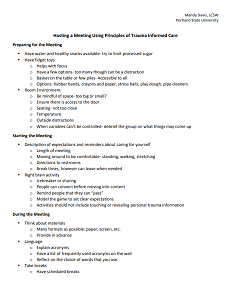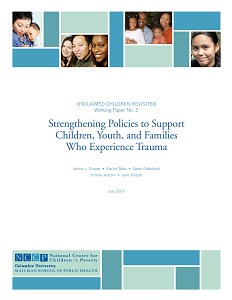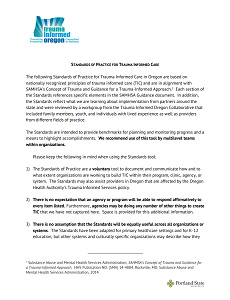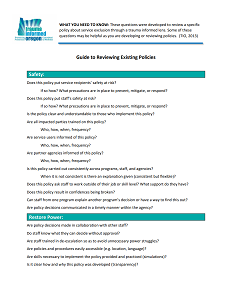-
Trauma Treatment- System-Level Programs (Child and Adolescents)
Organizational Policies & Procedures
California Evidence Based Clearinghouse (CEBC)GeneralThis webpage of the CEBC website highlights evidence-based system-level programs that are designed to help an organization provide trauma-informed care or trauma-informed services.
-
Hosting a Meeting Using Principles of Trauma Informed Care
Organizational Policies & Procedures
Trauma Informed OregonGeneralThis document – offered in Spanish and English- discusses things one can do to prepare for and run a meeting that is trauma informed.
-
Human Resources Practices to Support TIC
Organizational Policies & Procedures
Trauma Informed OregonGeneralThis document discusses how to promote trauma informed care through human resource policies and practices, including hiring, onboarding, supervision and performance reviews.
-
Developing a Trauma-Informed Child Welfare System
Organizational Policies & Procedures
Child Welfare Information GatewayChild WelfareThis issue brief discusses the steps that may be necessary to create a child welfare system that is more sensitive and responsive to trauma. Every child welfare system is different, and each State or county child welfare system will need to conduct its own systematic process of assessment and planning, in collaboration with key partners, to determine the best approach. After providing a brief overview of trauma and its effects, this issue brief discusses some of the primary areas of consideration in that process, including workforce development, screening and assessment, data systems, evidence-based and evidence-informed treatments, and funding.
-
Policy Guidance for Trauma Informed Human Resources
Organizational Policies & Procedures
Missouri Trauma Roundtable through the Department of Mental HealthGeneralThis document is intended for use by multiple systems. It divides human resource activities into four stages of employment, and discusses trauma-informed considerations for each stage.
-
Strengthening Policies to Support Children, Youth, and Families Who Experience Trauma
Organizational Policies & Procedures
National Center for Children in PovertyGeneralThis report reviews current policies and practices to support children, youth, and families exposed to trauma, highlights current inadequacies and emerging best practices, and provides recommendations for the future.
-
Trauma Informed & Trauma-Responsive Organizations and Systems
Organizational Policies & Procedures
Safe Hands Thinking MindsGeneralThis website offers creative resources for professionals working with child trauma, as well as recommended websites and links around trauma-informed organizations, systems, and practice
-
Trauma Informed & Trauma-Responsive Organizations and Systems
Organizational Policies & Procedures
Safe Hands Thinking MindsGeneralThis website offers creative resources for professionals working with child trauma, as well as recommended websites and links around trauma-informed organizations, systems, and practice
-
Trauma Informed Care Screening Tool
Organizational Policies & Procedures
Trauma Informed OregonGeneralThe trauma informed care screening tool outlines four developmental phases organizations navigate on their way to being trauma informed. Each phase is defined, and questions are posed to help an organization determine how each phase has looked for them, what they might like to work on, and how to measure change.
-
Trauma Informed Care Screening Tool
Organizational Policies & Procedures
Trauma Informed OregonGeneralThe trauma informed care screening tool outlines four developmental phases organizations navigate on their way to being trauma informed. Each phase is defined, and questions are posed to help an organization determine how each phase has looked for them, what they might like to work on, and how to measure change.
-
Standards of Practice for Trauma Informed Care
Organizational Policies & Procedures
Trauma Informed OregonGeneralThis document describes that Standards of Practice for Trauma-Informed Care in Oregon and is intended to provide benchmarks for planning and monitoring progress. This tool is meant to be used by multiple teams throughout an organization
-
THRIVE Guide to Trauma-Informed Organizational Development
Organizational Policies & Procedures
THRIVE InitiativeGeneralThis guide is designed to help agencies develop strategies to create and enhance trauma-informed system of care service approaches. The guide goes through stages of implementation, domains of trauma informed care (e.g., safety, youth and family empowerment), and technical assistance resources.
-
Guide to reviewing existing policies
Organizational Policies & Procedures
Trauma Informed OregonGeneralThis document discusses ways to help organizations review a specific policy about service exclusion through a trauma informed lens.
-
Organizational Considerations In Becoming Trauma Informed: First Steps 2017
Organizational Policies & Procedures
Missouri Trauma Roundtable through the Department of Mental HealthGeneralThis succinct document outlines key considerations for organizations interested in becoming trauma informed, including organizational readiness, leadership, and strategic planning. It also outlines steps towards effective organizational change.
-
Trauma Informed & Trauma-Responsive Organizations and Systems
Organizational Policies & Procedures
Safe Hands Thinking MindsGeneralThis website offers creative resources for professionals working with child trauma, as well as recommended websites and links around trauma-informed organizations, systems, and practice
-
Trauma Informed Care Screening Tool
Organizational Policies & Procedures
Trauma Informed OregonGeneralThe trauma informed care screening tool outlines four developmental phases organizations navigate on their way to being trauma informed. Each phase is defined, and questions are posed to help an organization determine how each phase has looked for them, what they might like to work on, and how to measure change.
-
Standards of Practice for Trauma Informed Care
Organizational Policies & Procedures
Trauma Informed OregonGeneralThis document describes that Standards of Practice for Trauma-Informed Care in Oregon and is intended to provide benchmarks for planning and monitoring progress. This tool is meant to be used by multiple teams throughout an organization
-
THRIVE Guide to Trauma-Informed Organizational Development
Organizational Policies & Procedures
THRIVE InitiativeGeneralThis guide is designed to help agencies develop strategies to create and enhance trauma-informed system of care service approaches. The guide goes through stages of implementation, domains of trauma informed care (e.g., safety, youth and family empowerment), and technical assistance resources.
-
Guide to reviewing existing policies
Organizational Policies & Procedures
Trauma Informed OregonGeneralThis document discusses ways to help organizations review a specific policy about service exclusion through a trauma informed lens.
-
Organizational Considerations In Becoming Trauma Informed: First Steps 2017
Organizational Policies & Procedures
Missouri Trauma Roundtable through the Department of Mental HealthGeneralThis succinct document outlines key considerations for organizations interested in becoming trauma informed, including organizational readiness, leadership, and strategic planning. It also outlines steps towards effective organizational change.
-
Implementing TIC into Organizational Culture and Practice (SFDPH)
Organizational Policies & Procedures
Center for Health Care Strategies, Inc. (CHCS)GeneralThis 90-minute webinar highlights strategies for implementing trauma-informed organizational practices across large health systems.
-
Implementing TIC into Organizational Culture and Practice (SFDPH)
Organizational Policies & Procedures
Center for Health Care Strategies, Inc. (CHCS)GeneralThis 90-minute webinar highlights strategies for implementing trauma-informed organizational practices across large health systems.











